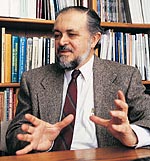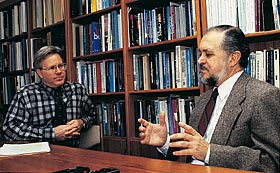Interview: Mario Molina

Mario Molina personifies two of this textbook's integrating themes: the multidisciplinary nature of biology and the relationship of science and technology to society. His research on the chemistry of the atmosphere's ozone layer and how certain pollutants are damaging that protective layer led to international awareness about a serious threat to life on Earth. In 1995, Dr. Molina was awarded the Nobel Prize in chemistry, along with Paul Crutzen and F. Sherwood Rowland. The Nobel citation clearly connected these chemists' research to biology and society: "By explaining the chemical mechanisms that affect the thickness of the ozone layer, the three researchers have contributed to our salvation from a global environmental problem that could have catastrophic consequences." I interviewed Dr. Molina in his office at the Massachusetts Institute of Technology, where he is a professor in the Department of Earth, Atmospheric, and Planetary Sciences.
Let's start with the atmosphere's ozone layer. Why is it important to life on Earth?
The ozone shield is important to biological systems because it shields the Earth's surface from powerful ultraviolet radiation that comes from the sun. This UV radiation is harmful to organisms, including humans. For example, UV radiation causes sunburn, and skin cancer can be a cumulative result of exposure. There is also evidence that UV can damage crops, such as soybeans. Certain developing animals, such as the larvae of fish, seem to be particularly sensitive. The atmosphere's ozone layer prevents most of this harmful UV radiation from reaching Earth. But it is the Achilles' heel of the atmosphere.
In what way?
The ozone shield, so crucial to life, is relatively thin and fragile. In fact, the whole atmosphere is thin, with most air located within about 30 miles of Earth. Compared to the size of the Earth, the atmosphere is like the skin of an apple. And within this thin atmosphere, ozone is very scarce, measured in parts per million. Most of that ozone is located about 15 miles from Earth, in the stratosphere. The ozone forms when high-energy solar radiation breaks apart oxygen molecules and frees oxygen atoms. These oxygen atoms then react with unbroken oxygen molecules, which consist of two bonded oxygen atoms. This forms ozone, which has three oxygen atoms. So ozone is continuously forming by the action of sunlight on the atmosphere, but this is balanced by continuous destruction of the unstable ozone molecules when they react with other chemical compounds that are naturally present in the atmosphere. We've disrupted that balance by releasing certain industrial chemicals that damage the fragile ozone layer.
That's a good segue to the story of your Nobel Prize. Tell us about that research.
In 1974 we published our first paper on the CFC-ozone depletion theory. We made a prediction based on laboratory experiments on atmospheric chemistry. We predicted that our continuous release of chlorofluorocarbons, or CFCs, such as Freon, which is a brand name, would damage the protective ozone layer. These compounds were used as refrigerants, as propellants in spray cans, as solvents, and in the process for making plastic foams. The CFCs were actually developed as replacements for toxic refrigerants. In fact CFCs are very stable, or unreactive, which is why they are not toxic. You can even breathe them, and nothing happens. But it is also the stability of CFCs that allows them to reach the ozone layer. Most other pollutants released into the air are removed before they reach the stratosphere. Water-soluble pollutants come back to the Earth very fast. And most pollutants that are not soluble in water, such as hydrocarbons, are oxidized by other gases in the lower atmosphere and are converted to water-soluble compounds. So the atmosphere has a pretty efficient cleansing mechanism, but only at low altitudes. The problem is that CFCs make it up to the stratosphere, where solar radiation finally converts them to very reactive chemical species called free radicals. Those free radicals then destroy the ozone.
 So, when you and your colleagues sounded this alarm in 1974, what was the reaction of the scientific community and the general public?
So, when you and your colleagues sounded this alarm in 1974, what was the reaction of the scientific community and the general public?
At first, there was very little reaction because not many people were aware of the importance of invisible things like the ozone layer and UV radiation. Experts in our research field quickly realized that the prediction of the CFC-ozone depletion theory was something to worry about, but many other scientists were skeptical, which is natural for scientists. Then as we and others in our field began doing experiments to test the idea, the case for the CFC-ozone depletion theory became strong and more and more people, including politicians, became concerned about the issue of ozone depletion. There was also growing awareness about the role of UV radiation in skin cancer and in other biological damage. Then, in 1985, scientists documented a drastic depletion of the ozone layer over the Antarctic, an ozone hole. This caused the United Nations to act in 1987.
And what was that action?
The UN Montreal Protocol of 1987 was an international agreement to reduce by one-half the amount of CFCs released into the atmosphere. Then, as evidence in support of the ozone depletion theory continued to grow, the Protocol was strengthened to require a complete phasing out of CFC production by developed countries by 1995. So that's already happened. Industrial countries are no longer manufacturing CFCs. Instead, these countries now use other refrigerants, which are destroyed in the atmosphere before they reach the ozone layer. The Montreal Protocol allowed a grace period for developing countries, a bit more time and some help from the industrial countries in the transition to CFC-free technology. That's in the works now, and CFCs will be phased out everywhere within the next decade.
Is the damage we've already inflicted on the ozone layer reversible?
Yes, because ozone is forming continuously in the atmosphere. But because CFCs are so stable and because they take so long to reach the ozone layer, the damage that we're seeing today is actually caused by CFCs released a decade ago. And CFCs will remain in the stratosphere for several more decades. So, we predict that the ozone layer won't recover until about the middle of the next century.
Your commitment to the relationship of science to society includes your service on the President's Committee of Advisors on Science and Technology. What have you learned from that experience about the interface between science and politics?
One lesson is that science is not always something that politicians care very much about. Often, supporting science is considered a luxury. But I think the scientific community has succeeded to some extent in putting science in the limelight. Supporting science is a good investment. Another challenge is that many issues related to science and technology are long-term issues that require patience and long-term commitment. An example is our excessive production of carbon dioxide and the related possibility of global warming. Let's say that ten to twenty years from now, we realize that we really are in trouble because of global warming. We will seem foolish if we did not invest in research now if global warming does turn out to be a serious problem, which we think is a reasonable possibility.
In terms of mounting an international effort, the global warming problem is an even tougher challenge than the ozone depletion problem, right?
Fortunately, we have the precedent of the Montreal Protocol, but, yes, the climate change issue is more complicated. First of all, the accumulation of gases that could warm the planet by what is known as the greenhouse effect is occurring mainly in the lower part of the atmosphere, which is a more complex system than the stratosphere. So, there are many more scientific uncertainties than we have for the ozone problem. But it is reasonable to predict that there will be consequences of our adding these greenhouse gases to the atmosphere. We can also tell that temperatures are indeed increasing, but it's not yet that clear that this is a consequence of human activities. One could argue that much of the change is natural, although there is more and more evidence that the planet's climate is being affected by human activities. But we don't have a smoking gun yet, like we did with the ozone hole over the Antarctic. The second important difference is that reducing the release of greenhouse gases requires much more social and economic change than does reducing the release of CFCs.
Tell us more about this challenge.
The most important greenhouse gas is the carbon dioxide we're releasing by burning fossil fuels and burning forests. This activity is related to energy sources, which are so important for society. Conserving energy and developing alternative energy requires much bigger change in our patterns than using other compounds in place of CFCs. What we're talking about is preserving a high standard of living and increasing the standard of living in developing countries. But we may be able to do that in clever ways, without consuming so much energy. We have some examples. Energy consumption per person in Europe is a lot less than it is in the United States. Clearly, there are some different habits. For one thing, gasoline for cars is very cheap here in the United States, so there is no incentive to be more efficient. With rapid, drastic change in energy use, we can predict that the economy would suffer. But with more gradual change and the right kind of planning and incentives, we can deal with the climate change issue. In fact, recent international agreements could change the way we use energy.
Will this seem like "changing rules" to the developing countries that are trying to improve their living standard?
That's an issue, but there is another important element that I've observed from my own experience. When I was a young person going to the university in Mexico, no one cared about pollution. Dealing with pollution seemed like a luxury. Today, everybody in Mexico City cares about pollution, so solving this problem no longer seems like something the industrialized countries want to impose upon them. The costs of pollution are enormous in Mexico City, where I was born. If only there had been insight about what would happen to the city, pollution could have been reduced at a much lower cost. It's much more difficult to repair the environment now, but I think there is a strong incentive to do that in developing countries. It's not easy because of the complications of social and economic issues. Science and technology are very important components, but not the only ones, so scientists will have to be humble and realize their limits.
You came to MIT in 1989 after several years as a researcher at the Jet Propulsion Lab in California. Why did you decide to return to the academic community?
The main reason was to have more interaction with students. I find it very stimulating both to teach undergraduate students in the classroom and also work with graduate students in research.
What general advice can you share with the undergraduate students reading this book?
First, students should be conscious about how fun it can be to study and learn, which is difficult to realize when there are so many hurdles to go over and the work sometimes seems overwhelming. But believe me, studying can be fun. To some extent, university education is changing. There are so many things to learn and so many new developments that there is no hope of covering everything. We are not just teaching facts, but teaching how to learn. Students should discuss ideas with their professors and become engaged. Try not to be just a passive student listening to lectures, but participate actively in the process of learning.
©2005 Pearson Education, Inc., publishing as Benjamin Cummings